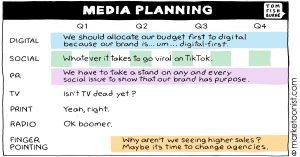— January 29, 2019

350543 / Pixabay
Back when video was expensive and rare, companies could get away with siloing their video production efforts. Now, however, video has evolved into an expectation, and with that expectation comes a requirement of quality that silos cannot address.
Most company leaders understand that they can’t throw money at agencies and expect the market to accept generic content created in a vacuum. It’s why 72 percent of companies now use a mix of internal and outsourced creative talent. Creation and consumption are closer than ever, resulting in a new, collaborative process in which you must create content you already know your audiences will love. When production teams and stakeholders work together on video content, they’re better able to create pieces that meet today’s higher standards.
Creative teams are also under more pressure to produce higher volume. They cannot keep that content relevant without input and feedback from the stakeholders requesting those videos. Stakeholders, too, cannot be upset about the relevance of a requested video if they fail to participate in the creative process.
Collaborative video creation helps your whole company align its goals, increase production speed, and create better pieces of content to make audiences happy. When everyone in your company gets involved, great ideas flow faster.
Filming an Uphill Battle
I’ve worked with many teams without a collaborative video production process. Those teams suffer a variety of issues that a bit of cooperation would solve quickly.
When videos get stuck waiting for approval, stakeholders are often reluctant to pull the trigger. They weren’t involved in the process, so how should they know if this video works? Sometimes, they barely remember what they wanted in the first place. By springing nearly completed videos on stakeholders, creative teams gamble with everyone’s time.
These review sessions rarely work out well. Videos created with limited input from the people who asked for them are rarely as effective as they would be if the requesters had been involved from the start.
To fix off-topic videos, most companies rely on strings of emails. This cumbersome process creates frustration for stakeholders and forces production teams to work with limited information. Occasionally, stakeholders find it easier to give up engagement entirely, which strikes a major blow to your ability to use video effectively.
Lack of collaboration isn’t limited to people problems, though. When systems only work for video creatives and not for your company in general, employees spend too much time hunting down files. (One study estimated that creatives look for media files 83 times per week.)
With strong collaboration between the people requesting the video and the people making it, content is more on topic, more like the requester’s vision, and more likely to finish on time. Marriott is a perfect example of a brand that understands this. With an emphasis on original, in-house content and a commitment to destroy organizational silos, Marriott has created an innovative video collaboration strategy that has increased revenue and earned the brand a host of marketing awards.
Facilitating Collaboration and Eliminating Confusion
To collaborate like Marriott and other brands with successful video production strategies, follow these helpful tips:
1. Define the process step by step.
Outline when different stakeholders can provide input — and make it easy for them to do so. When your team members have a predetermined feedback schedule, they can work faster and anticipate potential changes.
Take advantage of shared storage solutions to make sharing and commenting easy. Use permissions to give stakeholders access only to what they need so they don’t feel overwhelmed. Give everyone involved in the process a specific role (including what kind of input to provide) to keep videos from spiraling into an endless feedback loop.
2. Lead stakeholders with relevant questions.
On the topic of specific roles, lead stakeholders by asking pointed questions to answer as they review videos. Don’t send videos without context and ask for general feedback (e.g., “What do you think?”). That’s just begging for delays and nebulous or surface-level input. Instead, create a process where stakeholders can see the video and the questions to answer on the same screen. Ask questions like, “What weaknesses do you see in this frame?” to keep reviewers focused.
3. Gamify the review process.
People love to feel good about accomplishing something. Give them that satisfaction by turning the review process into a game. Deloitte, for instance, created a program with leaderboards and badges for executives who completed courses. This tactic cut average course completion time in half and results in a 46.6 percent increase in daily users. In video production, that kind of enthusiastic collaboration is invaluable.
4. Respond to all feedback.
Nothing feels sadder than getting involved with a project and realizing no one is paying attention. Make a point to respond to all feedback, even when you decline to implement it, to make stakeholders feel like valuable contributors. When feedback does make it into the final product, point out the changes to the people who suggested them. This creates a sense of ownership and encourages future cooperation from people who see their input brought to life.
Video content isn’t going away. If anything, increased availability and power of video production tools will boost the number of videos brands produce. By creating a collaborative process that involves both stakeholders and creative teams, companies can make more impactful, more relevant videos.
Want to streamline your team’s video production process to create better videos — faster? Simply fill out this form for a free trial of the Wipster app.
Digital & Social Articles on Business 2 Community
(86)







